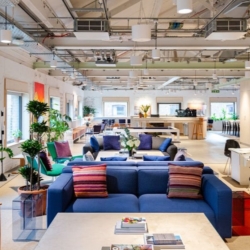 Last week we launched our first white paper: Carbon Conundrum to Carbon Control and we were so delighted to be joined by a panel of experts across development, , engineering, design and consultancy. Through their discussion and with excellent engagement from our audience of developers, designers, contractors, agents, engineers and end users, there were a number of very pertinent industry topics raised. The mood was upbeat and collaborative, but the emphasis was certainly on action and innovation, with a commitment to collective responsibility, education and being bolder.
Last week we launched our first white paper: Carbon Conundrum to Carbon Control and we were so delighted to be joined by a panel of experts across development, , engineering, design and consultancy. Through their discussion and with excellent engagement from our audience of developers, designers, contractors, agents, engineers and end users, there were a number of very pertinent industry topics raised. The mood was upbeat and collaborative, but the emphasis was certainly on action and innovation, with a commitment to collective responsibility, education and being bolder.
The paper was developed through contributions from leading sustainability experts across the UK, with a recognition that many issues facing the sector have never been more urgent. The model presented in the white paper has been founded on sustainability principles with what the authors says is ‘an ambition to bring positive, realistic, disruption to the heating and cooling market as part of the overall design and operational mix in the built environment’.
Areas of particular focus included:
Innovation – as an industry there needs to be less fear and a greater appetite for innovation. This can be in the form of technology, such as AI, or smarter solutions in HVAC, lighting and facades. This will require upskilling and more engagement and education of designers, tenants, developers, engineers, agents and facility managers. “If someone isn’t nourishing that building into performance, it’ll perform exactly the same way every time.”
But innovation also must come in the form of approach to retrofitting with tenants in situ, and not closing off buildings or leaving stranded assets to deteriorate. With a large number of the buildings that will be standing in 2050 already in place, we have to be more inventive about how retrofit happens. A typical building services design lasts 20 to 25 years and we only have 26 years until 2050. Everything in our approach Everything we do right now, both new build and refurbishment, must target net zero.
The government and other industry bodies need to innovate and be more committed to implementing measures and ensuring better access to funding, right across the country and for all types of building.
The greatest consensus came around a much more considered attitude to risk across the spectrum and demonstration that trying something different can work: “It is not the systems, it’s the data, transparency and proof that it works. We need supporting evidence – that is key.”
Carrot and stick culture
There has not been enough stick driving change and we need to see a much greater push if we are to bring about change. Business-as-usual is not going to achieve anything. “In an emergency we need a lot more stick.”
EPCs are one mechanism to drive change, but it is not nearly far-reaching enough to achieve the targets we really need to get to. Appetite for initiatives such as NABERS and MEES are not laws yet, and it is only at the more innovative scale (particularly in London) that they are being adopted. “That’s not good enough if we’re going to achieve the performance we need.”
Considered investors funding projects which harness new solutions will help drive a cultural mindset shift to prioritise carbon reduction and more efficient working environments. This is coming, but pretty slowly and we need to shift up several gears to make a difference. “people get it, but they don’t know the solutions and the actions to take.”
The carbon question
Whole life carbon is increasingly discussed, but with a supply chain hindered by lack of data it is still a challenge. But there are micro-economies like London and other cities around the world, where these requirements have to be considered or development won’t go ahead. “That’s what’s driving the change.”
Operational carbon measurement is about 20 years ahead of embodied carbon measurement. A challenge comes in that the embodied market is also much more global and requires a greater shift, but change is coming and more data and improved technology are driving this. “we can’t fire ourselves down the rabbit hole looking for every last piece of embodied carbon but techniques such as barcodes and more transparent manufacturing processes would make a real difference.”
An over-reliance on renewable energy does not consider the grid’s capability and isn’t really addressing the embodied carbon issue. We need to be thinking more broadly than that. More focus on re-use and component replacement in solutions will go a long way to addressing these issues and we need to see more innovation of this type to address whole life carbon.
Simplifying design
Removing complicated design and educating occupiers and facilities managers will make a significant impact and is arguably simpler than starting from scratch. Solution providers revisiting buildings, new and refurbished after six months and then after two years will go a long way to understanding what is working, what isn’t and framing the discussions around why and how to change it in future. “We need to make sure that that loop closes so you always end up with a better system. If a manufacturer or designer knows, they can make changes.”
Running thought every part of the design and implementation process is the addition of layers of safety factor. For example, chillers are over specified by designers to meet constant peak loads regardless of season or occupancy. Added to this specifiers increase the capacity to enable redundancy in case of failure.
Long life, loose fit – must become a more heavily adopted mantra. We are spending too much on materials in buildings. We should be using less materials, more carefully sourced and more efficiently used. “Money is finite and there are many other priorities in society today and the whole industry needs to be cognisant of that.”
Educating tenants is also important – we need to work together to actually understand what systems they are using, utilising more technology and data through simple BMS to monitor and adjust accordingly. “No one really has the knowledge of benchmarking energy use in the tenancy world. We need to help them with that and it doesn’t have to be over-complicated.”
We are aware that at the moment there is a London-centric focus for much of this activity, but the demand exists across the country. However, for every development, retrofit or upgrade there must be a business case. It has to stack financially, environmentally, operationally and socially.
Roger Olsen is Chief Technical Officer at Artus Air
Image: WeWork with units from Artus



















April 4, 2024
When it comes to the carbon conundrum, real change will come from collaboration
by Roger Olsen • Comment, Environment, Facilities management, Property, Wellbeing
The paper was developed through contributions from leading sustainability experts across the UK, with a recognition that many issues facing the sector have never been more urgent. The model presented in the white paper has been founded on sustainability principles with what the authors says is ‘an ambition to bring positive, realistic, disruption to the heating and cooling market as part of the overall design and operational mix in the built environment’.
Areas of particular focus included:
Innovation – as an industry there needs to be less fear and a greater appetite for innovation. This can be in the form of technology, such as AI, or smarter solutions in HVAC, lighting and facades. This will require upskilling and more engagement and education of designers, tenants, developers, engineers, agents and facility managers. “If someone isn’t nourishing that building into performance, it’ll perform exactly the same way every time.”
But innovation also must come in the form of approach to retrofitting with tenants in situ, and not closing off buildings or leaving stranded assets to deteriorate. With a large number of the buildings that will be standing in 2050 already in place, we have to be more inventive about how retrofit happens. A typical building services design lasts 20 to 25 years and we only have 26 years until 2050. Everything in our approach Everything we do right now, both new build and refurbishment, must target net zero.
The government and other industry bodies need to innovate and be more committed to implementing measures and ensuring better access to funding, right across the country and for all types of building.
The greatest consensus came around a much more considered attitude to risk across the spectrum and demonstration that trying something different can work: “It is not the systems, it’s the data, transparency and proof that it works. We need supporting evidence – that is key.”
Carrot and stick culture
There has not been enough stick driving change and we need to see a much greater push if we are to bring about change. Business-as-usual is not going to achieve anything. “In an emergency we need a lot more stick.”
EPCs are one mechanism to drive change, but it is not nearly far-reaching enough to achieve the targets we really need to get to. Appetite for initiatives such as NABERS and MEES are not laws yet, and it is only at the more innovative scale (particularly in London) that they are being adopted. “That’s not good enough if we’re going to achieve the performance we need.”
Considered investors funding projects which harness new solutions will help drive a cultural mindset shift to prioritise carbon reduction and more efficient working environments. This is coming, but pretty slowly and we need to shift up several gears to make a difference. “people get it, but they don’t know the solutions and the actions to take.”
The carbon question
Whole life carbon is increasingly discussed, but with a supply chain hindered by lack of data it is still a challenge. But there are micro-economies like London and other cities around the world, where these requirements have to be considered or development won’t go ahead. “That’s what’s driving the change.”
Operational carbon measurement is about 20 years ahead of embodied carbon measurement. A challenge comes in that the embodied market is also much more global and requires a greater shift, but change is coming and more data and improved technology are driving this. “we can’t fire ourselves down the rabbit hole looking for every last piece of embodied carbon but techniques such as barcodes and more transparent manufacturing processes would make a real difference.”
An over-reliance on renewable energy does not consider the grid’s capability and isn’t really addressing the embodied carbon issue. We need to be thinking more broadly than that. More focus on re-use and component replacement in solutions will go a long way to addressing these issues and we need to see more innovation of this type to address whole life carbon.
Simplifying design
Removing complicated design and educating occupiers and facilities managers will make a significant impact and is arguably simpler than starting from scratch. Solution providers revisiting buildings, new and refurbished after six months and then after two years will go a long way to understanding what is working, what isn’t and framing the discussions around why and how to change it in future. “We need to make sure that that loop closes so you always end up with a better system. If a manufacturer or designer knows, they can make changes.”
Running thought every part of the design and implementation process is the addition of layers of safety factor. For example, chillers are over specified by designers to meet constant peak loads regardless of season or occupancy. Added to this specifiers increase the capacity to enable redundancy in case of failure.
Long life, loose fit – must become a more heavily adopted mantra. We are spending too much on materials in buildings. We should be using less materials, more carefully sourced and more efficiently used. “Money is finite and there are many other priorities in society today and the whole industry needs to be cognisant of that.”
Educating tenants is also important – we need to work together to actually understand what systems they are using, utilising more technology and data through simple BMS to monitor and adjust accordingly. “No one really has the knowledge of benchmarking energy use in the tenancy world. We need to help them with that and it doesn’t have to be over-complicated.”
We are aware that at the moment there is a London-centric focus for much of this activity, but the demand exists across the country. However, for every development, retrofit or upgrade there must be a business case. It has to stack financially, environmentally, operationally and socially.
Roger Olsen is Chief Technical Officer at Artus Air
Image: WeWork with units from Artus